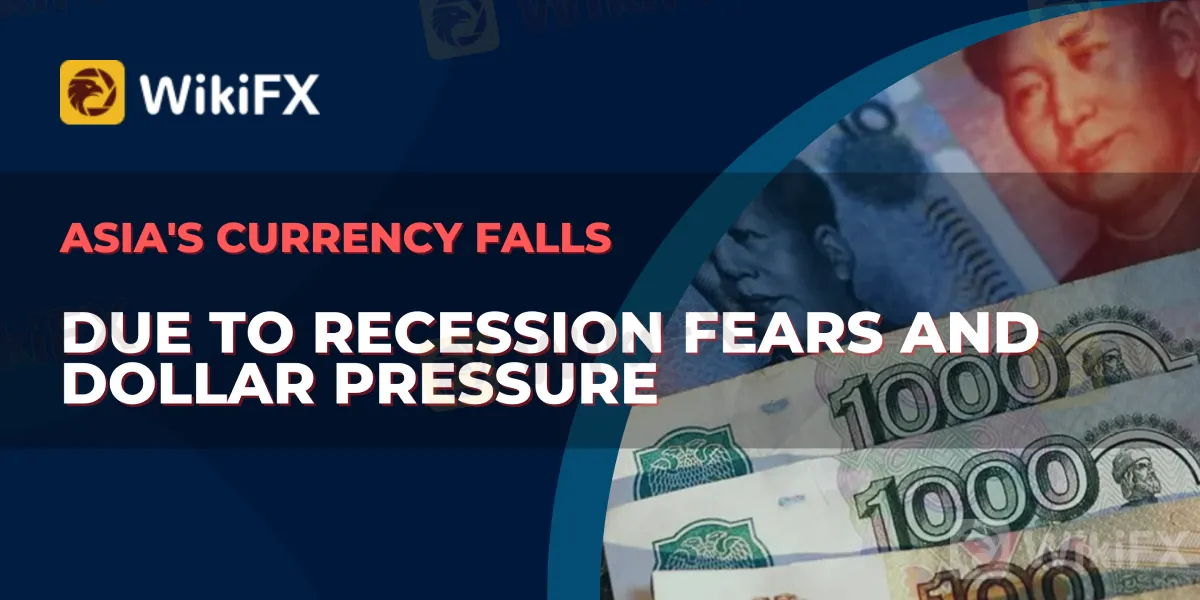简体中文
繁體中文
English
Pусский
日本語
ภาษาไทย
Tiếng Việt
Bahasa Indonesia
Español
हिन्दी
Filippiiniläinen
Français
Deutsch
Português
Türkçe
한국어
العربية
Asia's Currency Falls Due To Recession Fears And Dollar Pressure
Abstract:On Monday, most Asian currencies sank dramatically against the US dollar as concerns about a worldwide recession and increasing interest rates in the West weighed heavily on risky assets.

China's yuan was one of the day's worst performers, falling 0.5% to a fresh 2-year low of 7.1643. Despite many efforts taken by the People's Bank of China to limit additional currency losses, the yuan plummeted.
The PBOC said that it would increase the foreign exchange risk reserve requirements for financial institutions, making shorting the currency more costly. In addition, the central bank established a positive daily midpoint for the yuan.
The developments come as the yuan has been pummeled this year by a combination of dollar appreciation, lax monetary policy, and slowing Chinese economic growth.
The attention is now on the next Chinese PMI data for September, which is expected on Friday, for more indications of a possible Chinese economic revival.
Other Asian currencies fell to multi-year lows as well. The Indian rupee fell to a historic low of over 81 per dollar, while the South Korean won fell 0.8% to a more than 13-year low.
The Philippine peso likewise touched a new low versus the US dollar, while the Thai baht was Southeast Asia's worst performer, falling 0.9%.
The Japanese yen surpassed 144 per dollar, returning to levels recorded before the government intervened in currency markets. According to data released on Monday, although Japanese company activity increased marginally in September, the economy's outlook remained hampered by rising inflation.
The dollar index and dollar futures remained locked above 20-year highs as worries of a worldwide economic crisis grew after a slew of disappointing European economic data last week. The anticipation of more Federal Reserve interest rate rises boosted the greenback.
Currencies outside of Asia fell as well. The British pound hit a new low, as the euro moved farther away from parity with the US dollar. Markets anticipated that increasing interest rates and soaring inflation would be a double blow for global economic development.
Rising US interest rates and worries of a future recession have pummeled high-yield, high-risk Asian currencies this year. This trend is projected to continue for the rest of the year.
About WikiFX
WikiFX is a platform for searching worldwide corporate financial information. Its primary duty is to provide the included foreign exchange trading organizations with basic information searching, regulatory license seeking, the credit assessment, platform identification, and other services.

Over 39,000 brokers, both licensed and unregistered, are listed on the network. WikiFX's staff has been hard at work with 30 financial authorities from across the world to verify that the information supplied is factual and correct.
Stay tuned for more Forex news.
Download the WikiFX App from the App Store or Google Play Store.

Disclaimer:
The views in this article only represent the author's personal views, and do not constitute investment advice on this platform. This platform does not guarantee the accuracy, completeness and timeliness of the information in the article, and will not be liable for any loss caused by the use of or reliance on the information in the article.
Read more

Alleged Concerns with TradeEU.global's Trading Practices
An individual trader has come forward with allegations of an unfavourable experience while using the services of the broker TradeEU.global.

Lured by False Promises: Malaysian Driver Lost RM218K to an Investment Scam
A 49-year-old e-hailing driver in Malaysia fell victim to a fraudulent investment scheme, losing RM218,000 in a matter of weeks. The scheme, which falsely promised returns of 3 to 5 per cent within just three days, left the individual financially devastated.

SFC Freezes $91M in Client Accounts Amid Fraud Probe
SFC freezes $91M in client accounts at IBHK, SBI, Monmonkey, and Soochow over suspected hacking and market manipulation during unauthorized online trades.

Italian Regulator Warns Against 5 Websites
The Italian regulator, CONSOB has issued a warning against five websites offering unauthorized financial services. This regulatory action aims to protect the public from fraudulent activities.
WikiFX Broker
Latest News
What Makes Cross-Border Payments Easier Than Ever?
Trader Exposes Unethical Practices by STP Trading
Saxo & Portuguese Bank Partnership
SEC Fines Broker-Dealers $275K for Incomplete SAR Filings
Lured by False Promises: Malaysian Driver Lost RM218K to an Investment Scam
FTX Sets March 2025 Timeline for Creditor Payouts: What It Means for Investors
What is an Economic Calendar? How it works
Italian Regulator Warns Against 5 Websites
SFC Freezes $91M in Client Accounts Amid Fraud Probe
Bybit Launches Gold & FX Treasure Hunt with Real Gold Rewards
Currency Calculator


